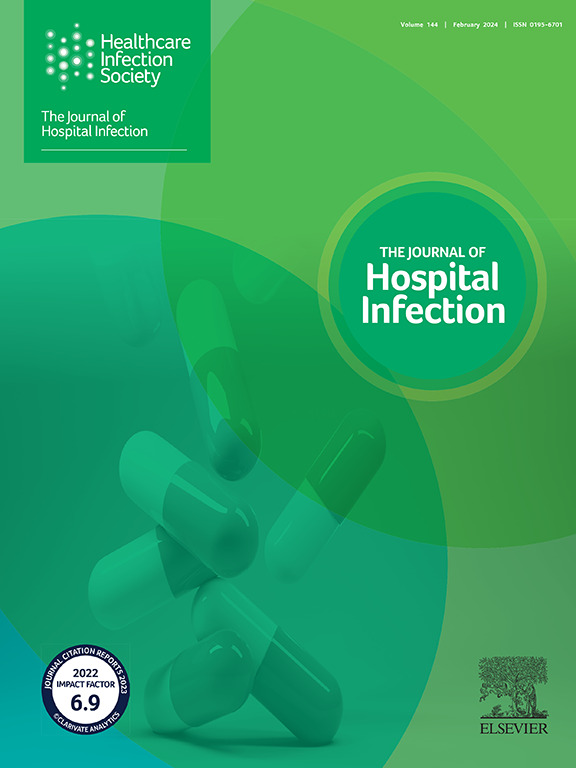碳青霉烯酶产生生物定植的患者环境特征:空气和表面在关键抗性基因传播中的作用。
IF 3.1
3区 医学
Q1 INFECTIOUS DISEASES
引用次数: 0
摘要
背景:碳青霉烯酶产生生物(CPOs)引起的医院获得性感染(HAIs)引起了重大的健康问题。卫生保健机构实施了控制CPO传播和预防暴发的措施,但空气在传播碳青霉烯酶基因中的作用仍不清楚。本研究评估了cpo定殖患者环境中碳青霉烯酶相关的三个基因(blaKPC, blaxa -48, blaNDM)。方法:在魁北克省的四家医院进行了一项前瞻性观察研究,在cpo殖民患者的房间中进行。在房间内积极收集空气,并使用预湿的拭子和海绵收集地板和非接触样本,并与位于同一楼层的控制室(即容纳非cpo定植患者)进行比较。在邻近的走廊收集了额外的地板样本,以估计在设置内的潜在传播。利用qPCR技术评估碳青霉烯酶产生基因(blaKPC、blaNDM和blaOXA-48)的存在和丰度。结果:碳青霉烯酶编码基因在cpo定域的患者环境中经常被检测到,特别是在地板(97%的检测频率)、门框(52%)和无接触表面(42%)。相反,只有一个空气样本检测出blaKPC阳性。这些基因在相邻走廊(92%)、控制室(100%)和控制室走廊(78%)也被检测到,丰度随着距离cpo殖民房间的距离而降低。结论:这些发现表明碳青霉烯耐药性可以在医疗机构内传播,空气可能在基因传播中起作用。应考虑采取其他措施限制抗性基因的转移,特别是通过地板和空气的转移。本文章由计算机程序翻译,如有差异,请以英文原文为准。
Characterization of the environment of patients colonized with carbapenemase-producing organisms: role of air and surfaces in the dissemination of key resistance genes
Background
Hospital-associated infections caused by carbapenemase-producing organisms (CPOs) pose a significant health concern. Healthcare settings implement measures to control the spread of CPOs and prevent outbreaks, but the role of air in disseminating carbapenemase genes remains unclear. This study assessed three carbapenemase-associated genes (blaKPC, blaOXA-48 and blaNDM) in the environment of CPO-colonized patients.
Methods
A prospective observational study was conducted in four hospitals in Quebec, Canada in the rooms of CPO-colonized patients. Air was collected actively inside the rooms of CPO-colonized patients, and floor and no-touch surfaces were sampled using pre-moistened swabs and sponges; the findings were compared with those from control rooms (i.e. rooms hosting non-CPO-colonized patients) located on the same floor. Additional floor samples were collected in adjacent hallways to estimate potential dissemination within the settings. The presence and abundance of carbapenemase-producing genes (blaKPC, blaNDM and blaOXA-48) were evaluated using quantitative polymerase chain reaction.
Results
Carbapenemase-encoding genes were detected frequently in CPO-colonized patient environments, notably on floors (97% of detection frequency), door frames (52%), and no-touch surfaces (42%). Conversely, only one air sample tested positive for blaKPC. These genes were also detected in hallways adjacent to the rooms of CPO-colonized patients (92%), control rooms (100%), and hallways adjacent to the rooms of non-CPO-colonized patients (78%), with abundance decreasing with distance from CPO-colonized rooms.
Conclusion
These findings suggest that carbapenem resistance can spread within healthcare settings, and air may play a role in gene dissemination. Additional measures should be considered to limit resistance gene transfer, particularly via floors and air.
求助全文
通过发布文献求助,成功后即可免费获取论文全文。
去求助
来源期刊

Journal of Hospital Infection
医学-传染病学
CiteScore
12.70
自引率
5.80%
发文量
271
审稿时长
19 days
期刊介绍:
The Journal of Hospital Infection is the editorially independent scientific publication of the Healthcare Infection Society. The aim of the Journal is to publish high quality research and information relating to infection prevention and control that is relevant to an international audience.
The Journal welcomes submissions that relate to all aspects of infection prevention and control in healthcare settings. This includes submissions that:
provide new insight into the epidemiology, surveillance, or prevention and control of healthcare-associated infections and antimicrobial resistance in healthcare settings;
provide new insight into cleaning, disinfection and decontamination;
provide new insight into the design of healthcare premises;
describe novel aspects of outbreaks of infection;
throw light on techniques for effective antimicrobial stewardship;
describe novel techniques (laboratory-based or point of care) for the detection of infection or antimicrobial resistance in the healthcare setting, particularly if these can be used to facilitate infection prevention and control;
improve understanding of the motivations of safe healthcare behaviour, or describe techniques for achieving behavioural and cultural change;
improve understanding of the use of IT systems in infection surveillance and prevention and control.
 求助内容:
求助内容: 应助结果提醒方式:
应助结果提醒方式:


